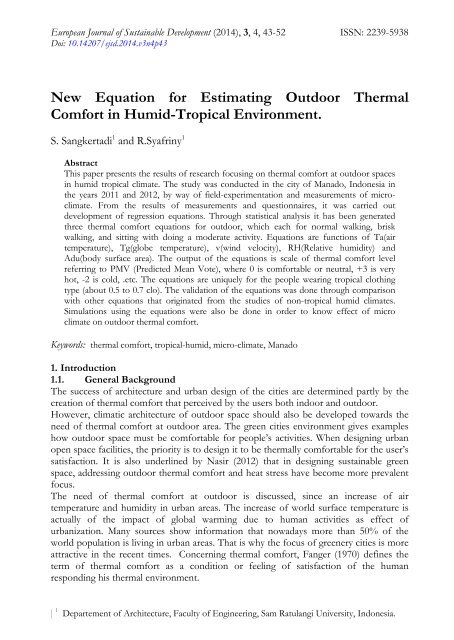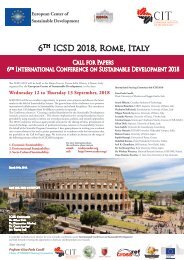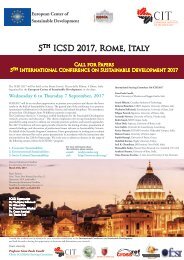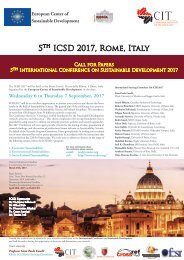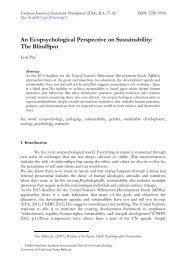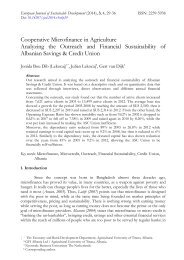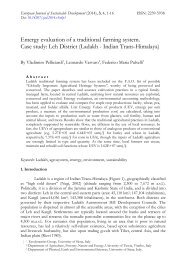European Journal of Sustainable Development (EJSD)
Rome Italy
Rome Italy
You also want an ePaper? Increase the reach of your titles
YUMPU automatically turns print PDFs into web optimized ePapers that Google loves.
<strong>European</strong> <strong>Journal</strong> <strong>of</strong> <strong>Sustainable</strong> <strong>Development</strong> (2014), 3, 4, 43-52 ISSN: 2239-5938<br />
Doi: 10.14207/ejsd.2014.v3n4p43<br />
New Equation for Estimating Outdoor Thermal<br />
Comfort in Humid-Tropical Environment.<br />
S. Sangkertadi 1 and R.Syafriny 1<br />
Abstract<br />
This paper presents the results <strong>of</strong> research focusing on thermal comfort at outdoor spaces<br />
in humid tropical climate. The study was conducted in the city <strong>of</strong> Manado, Indonesia in<br />
the years 2011 and 2012, by way <strong>of</strong> field-experimentation and measurements <strong>of</strong> microclimate.<br />
From the results <strong>of</strong> measurements and questionnaires, it was carried out<br />
development <strong>of</strong> regression equations. Through statistical analysis it has been generated<br />
three thermal comfort equations for outdoor, which each for normal walking, brisk<br />
walking, and sitting with doing a moderate activity. Equations are functions <strong>of</strong> Ta(air<br />
temperature), Tg(globe temperature), v(wind velocity), RH(Relative humidity) and<br />
Adu(body surface area). The output <strong>of</strong> the equations is scale <strong>of</strong> thermal comfort level<br />
referring to PMV (Predicted Mean Vote), where 0 is comfortable or neutral, +3 is very<br />
hot, -2 is cold, .etc. The equations are uniquely for the people wearing tropical clothing<br />
type (about 0.5 to 0.7 clo). The validation <strong>of</strong> the equations was done through comparison<br />
with other equations that originated from the studies <strong>of</strong> non-tropical humid climates.<br />
Simulations using the equations were also be done in order to know effect <strong>of</strong> micro<br />
climate on outdoor thermal comfort.<br />
Keywords: thermal comfort, tropical-humid, micro-climate, Manado<br />
1. Introduction<br />
1.1. General Background<br />
The success <strong>of</strong> architecture and urban design <strong>of</strong> the cities are determined partly by the<br />
creation <strong>of</strong> thermal comfort that perceived by the users both indoor and outdoor.<br />
However, climatic architecture <strong>of</strong> outdoor space should also be developed towards the<br />
need <strong>of</strong> thermal comfort at outdoor area. The green cities environment gives examples<br />
how outdoor space must be comfortable for people’s activities. When designing urban<br />
open space facilities, the priority is to design it to be thermally comfortable for the user’s<br />
satisfaction. It is also underlined by Nasir (2012) that in designing sustainable green<br />
space, addressing outdoor thermal comfort and heat stress have become more prevalent<br />
focus.<br />
The need <strong>of</strong> thermal comfort at outdoor is discussed, since an increase <strong>of</strong> air<br />
temperature and humidity in urban areas. The increase <strong>of</strong> world surface temperature is<br />
actually <strong>of</strong> the impact <strong>of</strong> global warming due to human activities as effect <strong>of</strong><br />
urbanization. Many sources show information that nowadays more than 50% <strong>of</strong> the<br />
world population is living in urban areas. That is why the focus <strong>of</strong> greenery cities is more<br />
attractive in the recent times. Concerning thermal comfort, Fanger (1970) defines the<br />
term <strong>of</strong> thermal comfort as a condition or feeling <strong>of</strong> satisfaction <strong>of</strong> the human<br />
responding his thermal environment.<br />
| 1 Departement <strong>of</strong> Architecture, Faculty <strong>of</strong> Engineering, Sam Ratulangi University, Indonesia.
44<br />
<strong>European</strong> <strong>Journal</strong> <strong>of</strong> <strong>Sustainable</strong> <strong>Development</strong> (2014), 3, 4, 43-52<br />
Recently, the principal objective <strong>of</strong> thermal comfort criteria is mostly for standardization<br />
<strong>of</strong> buildings types and its equipments in order to achieve energy efficiency and indoor<br />
environmental friendly. However, from the view<br />
point <strong>of</strong> thermal perception, the<br />
problem occurred at outdoor space<br />
may be different from the indoor situation and may<br />
lead to the different<br />
concept <strong>of</strong> thermal comfort for outdoor spaces. The mean radiant<br />
temperature <strong>of</strong> inner surfaces in such indoor spaces is same or almost same as its indoor<br />
air temperature due<br />
to the closed characteristic <strong>of</strong><br />
rooms and that well protected<br />
from<br />
outdoor thermal environment. But at outdoor, especially in tropical regions, average <strong>of</strong><br />
radiant temperatures is significantly more influenced by direct solar radiation and<br />
surfaces temperature (material <strong>of</strong> streets, pedestrians, buildings<br />
envelop, and other<br />
surfaces <strong>of</strong> urban furniture), and may reach a value that much higher than the outdoor<br />
air temperature. This paragraph may leads us to put hypothesis that the mean radiant<br />
temperature contribute as the most sensitive micro climate component on outdoor<br />
comfort <strong>of</strong> human activities in humid tropical region.<br />
1.2. The City <strong>of</strong> Manado and its climate<br />
Manado is one <strong>of</strong> the cities that geographically positioned at warm and humid climate<br />
region, in Indonesia. The climate is characterized by<br />
relatively high air temperature,<br />
much<br />
sun-lighhabitat <strong>of</strong> about 410 thousands people in 2012.The population density is about 2650<br />
and high humidity. Manado is the coastal city located in 1,5 N and 125 E, with<br />
people/km 2 . The average diurnal air temperature is<br />
varied between<br />
about 20 0 C to<br />
32 0 C.<br />
Relative air humidity, in average is about 70% to 90%. Daily solar radiation may<br />
reach<br />
more<br />
than 4000 Wh/m 2 (Fig.2 & 3). Manado is a waterfront city<br />
that consisted 20 km<br />
long<br />
<strong>of</strong> coastal lines, having sloping<br />
landscape natural scenery and<br />
plenty <strong>of</strong> smalll rivers<br />
flow<br />
into the sea. Manado as the capital <strong>of</strong> province <strong>of</strong> Sulawesi Utara (North Sulawesi,<br />
Indonesia), has great opportunity to develop outdoor space as public places at<br />
some<br />
strategic areas for providing the need <strong>of</strong> outdoor activities. As an enjoyable place<br />
in the<br />
city, open space design should begin with an understanding <strong>of</strong> the future use <strong>of</strong> the<br />
property, and the proper design willl be unique to a specific site and<br />
should be based on a<br />
careful review process. In case <strong>of</strong> Manado, urban changed occurred significantly in very<br />
short term.<br />
Figure.1. Aerial view <strong>of</strong> Manado City (source: YP Photography and authors)<br />
1.3. Related studies<br />
There are fundamental differences concerning the method <strong>of</strong> calculation <strong>of</strong> the thermal<br />
comfort for indoor and outdoor, especially in tropical humid environment. At outdoor<br />
penetration <strong>of</strong> direct solar radiation<br />
and its radiant temperature can affect significantly<br />
Published by ECSDEV, Via dei Fiori, 34, 00172, Rome, Italy<br />
http://ecsdev.org
S. Sangkertadi and R. Syafriny<br />
45<br />
34<br />
32<br />
MAX<br />
AVG<br />
MIN<br />
34<br />
32<br />
MAX AVG MIN<br />
Deg. Celcius<br />
30<br />
28<br />
26<br />
24<br />
Deg. Celcius<br />
30<br />
28<br />
26<br />
24<br />
22<br />
20<br />
18<br />
Air Temperature<br />
January 2011<br />
22<br />
20<br />
18<br />
Air Temperature<br />
July<br />
2011<br />
Local Time<br />
Local Time<br />
Figure.2. Air temperature pr<strong>of</strong>ile (source: Meteorology Station <strong>of</strong><br />
Manado 2011)<br />
Wh/m2<br />
2<br />
7000<br />
6000<br />
5000<br />
4000<br />
3000<br />
2000<br />
1000<br />
0<br />
Solar Radiation<br />
%<br />
100<br />
80<br />
60<br />
40<br />
20<br />
0<br />
Relative Humidity<br />
Jan<br />
Feb<br />
Mar<br />
Avr<br />
May<br />
Jun<br />
Jul<br />
Aug<br />
Sep<br />
Oct<br />
Nov<br />
Dec<br />
Month<br />
the<br />
level <strong>of</strong> human thermal comfort. Contrary in the closed room, the radiant<br />
temperature (as average <strong>of</strong> radiant<br />
temperatures <strong>of</strong> internal surfaces: wall-ceiling-floor) is<br />
similar or has little difference than indoor air temperature.<br />
Figure.3. Monthly average solar Radiation and humidity (source: Meteorology Station <strong>of</strong> Manado 2011)<br />
Figure.4. Some open spaces in Manado<br />
That’s why in closed space the radiant temperature may not strong enough as<br />
determinant variable to influence the perception <strong>of</strong> thermal comfort. At the outdoor the<br />
radiant temperature from solar radiation (direct or indirect) may sting the body skin and<br />
cause a feel <strong>of</strong> uncomfortable thermally. In addition, at outside air velocity is generally<br />
greater than in closed room, fortunately the air mass may support the process <strong>of</strong><br />
achievement <strong>of</strong> thermal comfort by convection and sweat evaporation. In this context,<br />
Arens E and Ballanti D (1997) through a field study, has found significant effect <strong>of</strong> wind<br />
speed on human comfort for walking people in open space.<br />
© 2014 The Authors. <strong>Journal</strong> Compilation © 2014 <strong>European</strong> Center <strong>of</strong> <strong>Sustainable</strong> <strong>Development</strong>.
46 <strong>European</strong> <strong>Journal</strong> <strong>of</strong> <strong>Sustainable</strong> <strong>Development</strong> (2014), 3, 4, 43-52<br />
The studies <strong>of</strong> Nikolopoulou & Steemers (2003), Nikolopoulou, Lykoudis and Kikira<br />
(2008) and Ahmed KS (2003) concerning the investigation <strong>of</strong> human thermal comfort in<br />
outdoor space, indicate that when the same climatic condition is applied, the response <strong>of</strong><br />
discomfort at outdoor space is generally smaller compared to the situation when people<br />
are in closed room. There is then, a tendency for people, will be more tolerant in<br />
response to climatic conditions at outside than in a closed space.<br />
Researches on modeling the thermal comfort calculations for outdoor space, especially in<br />
the case <strong>of</strong> humid tropical climate are still relatively rare, mostly more interested for the<br />
cases <strong>of</strong> indoor space. If there are the models are based on empirical studies <strong>of</strong> outdoor<br />
space in cold, temperate and sub tropical climate areas, which are generally based on field<br />
studies in cities in America, Europe, Japan, Hongkong-China, and Australia. Those such<br />
researches carried out by Huang J (Huang et al, 2007), Matzarakis, Mayer & Rutz (2003),<br />
Nikolopoulou M, Lykoudis and Kikira M (2008), Lin TP, Matzarakis and Huang (2010),<br />
Scudo G and Dessi V (2006), J R Spagnolo and de Dear (2003) etc. Thermal comfort<br />
calculation model that be generated through a number <strong>of</strong> studies by those researchers<br />
may be not necessarily appropriate to be applied in cases <strong>of</strong> humid tropical climate,<br />
because <strong>of</strong> possible differences in the perception <strong>of</strong> comfort by people in different<br />
geographical habitation.<br />
Some <strong>of</strong> the authors who conducted researches on outdoor thermal comfort, proposed<br />
regression equations as contribution in modeling calculation for practice quantification<br />
<strong>of</strong> outdoor thermal comfort perception. The regression equations are mostly functions<br />
<strong>of</strong> climate variables such are solar radiation, air temperature, air humidity, wind speed,<br />
and radiant temperature, as shown in Table 1.<br />
Some others researchers have also proposed the temperature index to measure the<br />
level <strong>of</strong> comfort for people at a particular climatic environment, as the Out_SET<br />
(Outdoor Standard Effective Temperature), and TEP (Temperature Effective<br />
Psychologically) by Monteiro and Alucci (2009).<br />
Table.1.<br />
Regression Equations for outdoor thermal comfort<br />
Author(s), Year Equation Climate<br />
Monteiro L M and Alucci M Tsp= -3.557 +0.0632Ta +0.0677Tmr Sub Tropical<br />
P, 2009<br />
+0.0105RH -0.304v<br />
Nikolopoulou M, Lykoudis ASV=0.061Ta +0.091Tg -0.324v +0.03RH -<br />
Moderate<br />
S, Kikira M, 2003<br />
1.455<br />
Cheng V, Ng Edward, 2008 Ts (CHENG) =0.1895Ta -0.7754v +0.0028.S Sub Tropical<br />
Nicol F, Wilson E,<br />
Ueberjahn-Tritta A,<br />
Nanayakkara L and Kessler<br />
M, 2006<br />
Monteiro L M and Alucci M<br />
P, 2009<br />
Givoni & Noguchi (Source:<br />
Gaitani and Santamouris, 2005)<br />
+0.1953hr -8.23<br />
C=1.761 +0.132Ta +0.00108S -0.432 v 0.5<br />
TEP= -3.777 + 0.4828 Ta + 0.5172 Trm +<br />
0.0802 RH – 2.322 va<br />
Ts (GIVONI) =1.7 +0.1118Ta +0.0019S -0.322v -<br />
0.0073RH +0.0054Ts<br />
Cold<br />
Sub Tropical<br />
Cold<br />
Published by ECSDEV, Via dei Fiori, 34, 00172, Rome, Italy<br />
http://ecsdev.org
S. Sangkertadi and R. Syafriny 47<br />
A very good study by Mayer and Hoppe also proposed another temperature index that is<br />
known as PET (Physiologically Effective Temperature), a physiologically indices that<br />
were derived from the human energy balance for the assessment <strong>of</strong> the thermal complex.<br />
The PET which is limited for case <strong>of</strong> people wearing 0.9 clo with 200 W (activity) is now<br />
integrated into the RayMan Model (Matzarakis A, Rutz F, and Mayer H, 2007).<br />
2. Methods<br />
The methods <strong>of</strong> the study consist <strong>of</strong> outdoor experiment, measurements and<br />
regression analysis. By applying outdoor experimentation, 300 samples <strong>of</strong> adults<br />
participated as respondents/subjects (aged between 17 to 50 years) consisted <strong>of</strong> 180 men<br />
and 120 women. They were asked to wear a type <strong>of</strong> lightweight tropical clothing (0.5 -<br />
0.7 clo). Their weight and height were also measured in order to obtain inputs for<br />
calculating body surface area. The subjects were divided into 2 groups following to two<br />
types <strong>of</strong> location, that is at a place under shaded <strong>of</strong> trees (protected from direct sunlight),<br />
and at other place where it was fully exposed to direct sunlight (open-sky or sunny).<br />
These groups were then divided again into 3 sub groups <strong>of</strong> activities: normal walking<br />
(1.8-2.2 km/h; met=110 W/m 2 ), brisk walking (4-5 km/h; met=200 W/m 2 ) and sitting<br />
with medium activity (reading, speaking, doing computer). A treadmill was used as<br />
equipment for the samples/ subjects for walking facility with a constant speed. At same<br />
time a breeze <strong>of</strong> wind was directed to the body by applying a standing fan with a certain<br />
air velocity.<br />
Each subject has walked on treadmill for 2 minutes 5 times, with a pause <strong>of</strong> about 2<br />
minutes each. After walking <strong>of</strong> each 2 minutes, at a pause time, they filled simple<br />
questionnaire concerning their thermal comfort perception. At the same time,<br />
measurement <strong>of</strong> surface body skin temperature, air temperature, humidity, land surface<br />
temperature, air velocity and globe temperature were done. Measurement equipments<br />
used were: thermo-hygrometer, anemometer, infrared thermometer, solar-power meter,<br />
and globe thermometer. Period and time <strong>of</strong> outdoor experimentation was from May to<br />
July 2011 and July to September 2012 at day time (08.00 am to 05.00 pm).<br />
The data obtained from measurement and questionnaires were then compiled and<br />
analyzed with focusing on the correlation among three factors: the value represent <strong>of</strong><br />
thermal comfort perception, climate characteristics, and parameters <strong>of</strong> the human body.<br />
Then proceed with statistical analysis to obtain the regression equation Y = f (x, y), where<br />
‘Y’ is a number that indicates sense <strong>of</strong> thermal comfort, and ‘x’ is the climate variables<br />
(air temperature, globe temperature, relative humidity, air velocity, and solar radiation), ‘y’<br />
is the parameters and variable <strong>of</strong> the body (height, weight, skin temperature and dress).<br />
Table 2 shows the syntax <strong>of</strong> the thermal response that corresponded to integer value <strong>of</strong><br />
‘Y’. More detail explanation method <strong>of</strong> the study has published by same authors<br />
(Sangkertadi and Syafriny, 2012)<br />
3. Result and discussion<br />
3.1. The regression equations<br />
Based on the data from measurements and questionnaires and through a<br />
statistical analysis, three regressions equations have been successfully developed, and that<br />
© 2014 The Authors. <strong>Journal</strong> Compilation © 2014 <strong>European</strong> Center <strong>of</strong> <strong>Sustainable</strong> <strong>Development</strong>.
48 <strong>European</strong> <strong>Journal</strong> <strong>of</strong> <strong>Sustainable</strong> <strong>Development</strong> (2014), 3, 4, 43-52<br />
represent three modes <strong>of</strong> activities: normal walking, brisk walking and seated with a<br />
moderate action.<br />
Table. 2. Description <strong>of</strong> ‘Y’<br />
Value <strong>of</strong><br />
‘Y’<br />
Comfort Level Perception<br />
(refereed to PMV scale)<br />
-2 Cold<br />
-1 Cool<br />
0 Comfort/ Neutral<br />
1 Warm / Slightly hot<br />
2 Hot<br />
3 Very Hot<br />
4<br />
5<br />
Very-very Hot and feel pain<br />
Very not tolerable<br />
For the case <strong>of</strong> normal walking (speed <strong>of</strong> about 2 km/h), the regression equation is as<br />
follows:<br />
Y JS = -3.4 -0.36v +0.04Ta +0.08Tg -0.01RH + 0.96Adu<br />
(Multiple R = 0.70)<br />
For the case <strong>of</strong> brisk walking (speed <strong>of</strong> about 4-5 km/h) the regression equation was obtained:<br />
Y JC = 2.53 -0.29v +0.11Ta +0.05Tg -0.0009RH + 0.35Adu<br />
(Multiple R = 0.5)<br />
The regression equation for the case <strong>of</strong> seated people with moderate activity, is as follow:<br />
Y DS = -7.91 -0.52v +0.05Ta +0.17Tg -0.0007RH + 1.43Adu<br />
(Multiple R = 0.75)<br />
Where :<br />
v : Air velocity (m/s)<br />
Ta : Air temperature ( 0 C)<br />
Tg : Globe Temperature ( 0 C)<br />
RH : Relative Humidity (%)<br />
Adu : Area <strong>of</strong> body skin (surface <strong>of</strong> du Bois, m 2 )<br />
The coefficients and variables <strong>of</strong> the new three equations above are different from<br />
equations by other authors that be shown in the Table.1. In addition, the new equations<br />
take into account <strong>of</strong> the body skin surface (Adu) as variable, which is not considered by<br />
the other comparator equations.<br />
Some calculations by using the new equations have been done in order to know the<br />
sensitivity <strong>of</strong> the equations to micro-climate variables, where the results are shown by the<br />
graphics in the Figure.4a to 4h. The objective is to know the effect <strong>of</strong> air velocity on<br />
outdoor thermal comfort, coupled with variation <strong>of</strong> temperatures. The different values<br />
<strong>of</strong> Ta (air temperature) and Tg (globe temperature) were applied. It is shown, that wind<br />
velocity may influence to increase the sense <strong>of</strong> comfort significantly. It is indicated that<br />
increase <strong>of</strong> air velocity <strong>of</strong> 1 m/s may improve the scale <strong>of</strong> comfort level <strong>of</strong> around 0.5 to<br />
1.5 on average for three types <strong>of</strong> activity. It is also shown that Tg as representation <strong>of</strong><br />
mean radiant temperature play significant role in perception <strong>of</strong> comfort (presented in the<br />
Figures 4h and 4f).<br />
Published by ECSDEV, Via dei Fiori, 34, 00172, Rome, Italy<br />
http://ecsdev.org
S. Sangkertadi and R. Syafriny 49<br />
Comfort Scale (Y)<br />
3.0<br />
2.5<br />
2.0<br />
1.5<br />
1.0<br />
0.5<br />
0.0<br />
-0.5<br />
-1.0<br />
-1.5<br />
Ta=28 0 C; Tg=32 0 C<br />
0.5 1 1.5 2 2.5 3 3.5 4<br />
v (m/s)<br />
Yjs<br />
Yjc<br />
Yds<br />
Comfort Scale (Y)<br />
3.0<br />
2.5<br />
2.0<br />
1.5<br />
1.0<br />
0.5<br />
0.0<br />
-0.5<br />
-1.0<br />
-1.5<br />
-2.0<br />
Ta=28 0 C; Tg=28 0 C<br />
0.5 1 1.5 2 2.5 3 3.5 4<br />
v (m/s)<br />
Yjs<br />
Yjc<br />
Yds<br />
Figure.4a<br />
Figure.4b<br />
Comfort Scale (Y)<br />
3.0<br />
2.5<br />
2.0<br />
1.5<br />
1.0<br />
0.5<br />
0.0<br />
-0.5<br />
-1.0<br />
-1.5<br />
-2.0<br />
Ta=29 0 C; Tg=29 0 C<br />
0.5 1 1.5 2 2.5 3 3.5 4<br />
v (m/s)<br />
Yjs<br />
Yjc<br />
Yds<br />
Comfort Scale (Y)<br />
3.0<br />
2.5<br />
2.0<br />
1.5<br />
1.0<br />
0.5<br />
0.0<br />
-0.5<br />
-1.0<br />
-1.5<br />
Ta=31 0 C; Tg=31 0 C<br />
0.5 1 1.5 2 2.5 3 3.5 4<br />
v (m/s)<br />
Yjs<br />
Yjc<br />
Yds<br />
Figure.4c<br />
Figure.4d<br />
Comfort Scale (Y)<br />
3.0<br />
2.5<br />
2.0<br />
1.5<br />
1.0<br />
0.5<br />
0.0<br />
-0.5<br />
-1.0<br />
-1.5<br />
Ta=32 0 C; Tg=32 0 C<br />
0.5 1 1.5 2 2.5 3 3.5 4<br />
Yjs<br />
Yjc<br />
Yds<br />
Comfort Scale (Y)<br />
3.0<br />
2.5<br />
2.0<br />
1.5<br />
1.0<br />
0.5<br />
0.0<br />
-0.5<br />
-1.0<br />
-1.5<br />
Ta=32 0 C; Tg=40 0 C<br />
0.5 1 1.5 2 2.5 3 3.5 4<br />
Yjs<br />
Yjc<br />
Yds<br />
v (m/s)<br />
v (m/s)<br />
Figure.4e<br />
Figure.4f<br />
Comfort Scale (Y)<br />
3.0<br />
2.5<br />
2.0<br />
1.5<br />
1.0<br />
0.5<br />
0.0<br />
-0.5<br />
-1.0<br />
-1.5<br />
Ta=30 0 C; Tg=30 0 C<br />
0.5 1 1.5 2 2.5 3 3.5 4<br />
Yjs<br />
Yjc<br />
Yds<br />
Comfort Scale (Y)<br />
3.0<br />
2.5<br />
2.0<br />
1.5<br />
1.0<br />
0.5<br />
0.0<br />
-0.5<br />
-1.0<br />
Ta=30 0 C; Tg=35 0 C<br />
0.5 1 1.5 2 2.5 3 3.5 4<br />
Yjs<br />
Yjc<br />
Yds<br />
v (m/s)<br />
v (m/s)<br />
Figure.4g<br />
Figure.4h<br />
© 2014 The Authors. <strong>Journal</strong> Compilation © 2014 <strong>European</strong> Center <strong>of</strong> <strong>Sustainable</strong> <strong>Development</strong>.
50<br />
<strong>European</strong> <strong>Journal</strong> <strong>of</strong> <strong>Sustainable</strong> <strong>Development</strong> (2014), 3, 4, 43-52<br />
The new regression equations that were found through this study<br />
are useful as tool aid<br />
for designing facilities in open-spaces <strong>of</strong> the cities in warm humid environment. For<br />
example, when designing <strong>of</strong> outdoor-cafes, installation <strong>of</strong> standing fan and canopies, may<br />
be required, in order to obtain the temperatures and air velocity<br />
sufficiently for user<br />
comforts (Figure.5). In this case, the optimum wind speed and maximum <strong>of</strong> radiant<br />
temperature can be<br />
determined by using the equation. Then it<br />
can be decided the<br />
position and types <strong>of</strong> fan, types <strong>of</strong> canopy and surface material at open-space. However<br />
to apply the equations, it requires climatic data that can be obtained from the results <strong>of</strong><br />
measurements, such<br />
as from meteorological stations or by direct measurement in situ. In<br />
general, many <strong>of</strong> published-meteorological-data, mentions only the hourly-daily <strong>of</strong> air<br />
temperature, humidity and wind. In<br />
order to complete the lack <strong>of</strong> data on solar radiation,<br />
radiant temperature and globe temperature, it can be obtained through calculations. The<br />
computer program ‘Matahari’ developed by Sangkertadi (2009), can be used to calculate<br />
solar<br />
radiation on various surfaces position. While to calculate Tg, it can be used equation<br />
from<br />
the study <strong>of</strong> Dimiceli, Piltz and Amburn (2011) that based on the values <strong>of</strong> Ta, v<br />
and RH.<br />
Figure.5. Fan and Canopy<br />
at open-spaces in tropical humid area.<br />
3.2. Comparative Study<br />
Comparison<br />
the equations<br />
with other calculation models (Table.1) was also<br />
realized. The objective is as validation <strong>of</strong> the equations by a comparative manner. It was<br />
found that there are<br />
difference values between the results by using the new equations<br />
from<br />
the study and<br />
other models where applying<br />
the same values <strong>of</strong> variables. The<br />
climate variables that applied for comparison are shown in the Table.3 which is typically<br />
represented <strong>of</strong> humid-tropical climate.<br />
The comparison <strong>of</strong> equations whichh is shown in the Figure.6 indicates that the results <strong>of</strong><br />
regression equation Yjs are almost the same as the<br />
results <strong>of</strong> Tsp. It is logical, as<br />
Tsp is<br />
formulation based on sub tropical climate, in which climatologically, it does not have<br />
widely differences compared to tropical humid climatic situation. Figure.6 also shows<br />
that there are significantly different results <strong>of</strong> calculation, between using new equation<br />
Yjs and other models such are C, Ts, and ASV, when a constant air velocity <strong>of</strong> 1 m/s is<br />
applied.<br />
Conclusion<br />
Components <strong>of</strong> thermal comfort equation for outdoor spaces formed not only <strong>of</strong> micro-<br />
climate factors but also the human factors (activity, size and clothing).<br />
Published by ECSDEV, Via dei Fiori, 34, 00172, Rome, Italy<br />
http://ecsdev.org
S. Sangkertadi and R. Syafriny 51<br />
Hour<br />
S RH Ta Ts Tg Trm<br />
(W/m 2 ) (%) ( 0 C) ( 0 C) ( 0 C) ( 0 C)<br />
7 113.42 57 27.5 31.0 37.0 39.2<br />
8 305.21 56 28.0 37.4 44.9 48.9<br />
9 488.59 55 30.2 45.2 52.9 58.3<br />
10 634.90 51 31.0 50.5 58.0 64.4<br />
11 728.43 52 31.5 53.8 61.1 68.2<br />
12 760.50 51 31.2 54.5 61.7 69.0<br />
13 728.43 52 31.9 54.2 61.5 68.6<br />
14 634.90 52 31.0 50.5 58.0 64.4<br />
15 360.96 56 28.4 39.5 45.2 49.2<br />
16 305.21 59 27.1 36.5 44.0 48.0<br />
17 113.42 59 27.3 30.8 36.8 39.0<br />
Table.3.<br />
Climatic variable (July in Manado) as<br />
input <strong>of</strong> calculation for comparison<br />
Comfort Sensation<br />
VVH 4.0<br />
VH 3.0<br />
2.0 H<br />
SH 1.0<br />
0.0 C<br />
-1.0 CL<br />
CLD -2.0<br />
Comparison <strong>of</strong> the regressions<br />
v=1 m/s; July; Tropics Humid<br />
7 8 9 10 11 12 13 14 15 16 17<br />
Yjs<br />
Tsp<br />
ASV<br />
TS Cheng<br />
TS Givoni<br />
C<br />
Figure.6. Comparison<br />
<strong>of</strong> equations;<br />
C=Comfort;<br />
SH=Slightly Hot;<br />
H=Hot; VH= Very<br />
Hot; VVH=Very<br />
Very Hot; CL=Cool;<br />
CLD=Cold<br />
Hour<br />
The sense <strong>of</strong> thermal comfort at outdoor spaces, is a function integrated <strong>of</strong> variables<br />
and parameters <strong>of</strong> air temperature (Ta), radiant temperature (Tg), wind speed (v) and<br />
human properties (activity, type <strong>of</strong> clothing, body size). Through this study it is found<br />
that thermal comfort equation for outdoor space in warm and humid environments is<br />
specific, and different from other equations which are available for other climates.<br />
The study shows, that in humid tropical climate, wind mass that touch the human body,<br />
can affect the sense <strong>of</strong> outdoor comfort significantly. Beside, mean radiant temperature<br />
that represented by global temperature influence the comfort significantly.<br />
Therefore, the practice to operate the standing fan in the outdoor space is reasonable to<br />
get a sense <strong>of</strong> comfort for the user. In addition, efforts to reduce radiant temperature by<br />
applying shading devices, and application <strong>of</strong> s<strong>of</strong>t surface material and non-heat reflector,<br />
are also the way to reach friendly environment <strong>of</strong> the cities in warm humid climate.<br />
© 2014 The Authors. <strong>Journal</strong> Compilation © 2014 <strong>European</strong> Center <strong>of</strong> <strong>Sustainable</strong> <strong>Development</strong>.
52 <strong>European</strong> <strong>Journal</strong> <strong>of</strong> <strong>Sustainable</strong> <strong>Development</strong> (2014), 3, 4, 43-52<br />
References<br />
Ahmed K S, (2003), Comfort in Urban Spaces: defining the boundaries <strong>of</strong> outdoor thermal comfort for the tropical urban<br />
environment, <strong>Journal</strong>: Energy & Building, vol 35 - 2003<br />
Arens E and Ballanti D, (1997), Outdoor Comfort <strong>of</strong> Pedestrians in Cities, Proceedings <strong>of</strong> The Conference on<br />
Physical Environment, Upper Derby, PA, US 1997.<br />
Cheng V, and Ng E, (2008), Wind for Comfort in High Density Cities, Proceedings <strong>of</strong> The Conference on<br />
Passive and Low Energy Architecture, Dublin 22 - 24 October 2008.<br />
Dimiceli V E, Piltz S F, Amburn S A, (2011), Estimation <strong>of</strong> Black Globe Temperature for Calculation <strong>of</strong> the Wet Bulb<br />
Globe Temperature Index. Proceedings <strong>of</strong> the World Congress on Engineering and Computer<br />
Science-2011 Vol II WCECS 2011, October 19-21, 2011, San Francisco, USA<br />
Fanger P O, (1970), Thermal Comfort – Analysis and Applications in Environmental Engineering, McGraw Hill, New<br />
York.<br />
Gaitani, N, Santamouris M, Mihalakakou G, (2005), Thermal comfort conditions in outdoor spaces, Proceedings <strong>of</strong><br />
International Conference “Passive and Low Energy Cooling May 2005, Santorini, Greece.<br />
Givoni B, and Noguchi, M, (2000), Issues in outdoor comfort research. Proceedings <strong>of</strong> The Conference Passive<br />
and Low Energy Architecture, London, 2000.<br />
Huang J, (2007), Prediction <strong>of</strong> air temperature for thermal comfort <strong>of</strong> people in outdoor environments. Int. <strong>Journal</strong> on<br />
Biometeorology Vol.51, 2007<br />
International Standard Organization, (2003), ISO Standard 7730: Moderate thermal environments – Determination <strong>of</strong><br />
the PMV and PPD indices and specification <strong>of</strong> the conditions for thermal comfort, 2003.<br />
Lin, T.-P. , Matzarakis, A., Hwang, R.-L., Huang, Y.-C, (2010), Effect <strong>of</strong> pavements albedo on long-term outdoor<br />
thermal comfort. Proceedings <strong>of</strong> the 7th Conference on Biometeorology, 2010.<br />
Lin, T.-P., Andrade, H., Hwang, R.-L., Oliveira, S., Matzarakis, A.,(2008), The comparison <strong>of</strong> thermal sensation and<br />
acceptable range for outdoor occupants between Mediterranean and subtropical climates. Proceedings 18th<br />
International Congress on Biometeorology, September 2008.<br />
Matzarakis A, Mayer H, Rutz F, (2003), Radiation and Thermal Comfort, Proceeding <strong>of</strong> 6 th Hellenic Conference<br />
in Meteorology, Climatology and Atmospheric Physics, 2003.<br />
Matzarakis A, Rutz F, and Mayer H, (2007), Modelling radiation fluxes in simple and complex environments—<br />
application <strong>of</strong> the RayMan model. Int J Biometeorology, Vol. 51, 2007.<br />
Monteiro L M, Alucci M P, (2009), An Outdoor Thermal Comfort Index for the Subtropics. Proceeding 26 th PLEA,<br />
2009<br />
Nicol F, Wilson E, Ueberjahn-Tritta A, Nanayakkara L and Kessler M, (2006), Comfort in outdoor spaces in<br />
Manchester and Lewes, UK, Proceedings <strong>of</strong> conference: Comfort and Energy Use in Buildings - Getting<br />
them Right, Cumberland Lodge, Windsor, UK, 27-30 th April 2006. London<br />
Nikolopoulou, M and Steemers, K, (2003), Thermal comfort and psychological adaptation as a guide for designing urban<br />
spaces, Energy and Buildings, vol 35. 2003<br />
Nikolopoulou, M, Lykoudis, S and Kikira, M, (2008), Thermal comfort in urban spaces: field studies in Greece,<br />
Proceedings <strong>of</strong> the fifth International Conference on Urban Climate. September, 2008 Lodz,<br />
Poland.<br />
Nasir R A, Ahmad S Sh and Ahmed A Z, (2012), Psychological Adaptation <strong>of</strong> Outdoor Thermal Comfort in Shaded<br />
Green Spaces in Malaysia, Procedia - Social and Behavioral Sciences 68, 2012<br />
Sangkertadi and Syafriny R, (2012), Proposition <strong>of</strong> Regression Equations to Determine Outdoor Thermal Comfort in<br />
Tropical and Humid Environment, IPTEK, The <strong>Journal</strong> for Technology and Science, Vol. 23, Number<br />
2, May 2012.<br />
Sangkertadi, (1994). Contribution al’Etude du ComportementThermoaureulique des Batiments en Climat Tropical Humide.<br />
Prise en Compte de la Ventilation Naturelle dans l’Evaluation du Confort, These de Doctorat<br />
(unpublished), INSA de Lyon.<br />
Sangkertadi. Petunjuk Pemakaian Program ‘Matahari’,(2009), Fakultas Teknik Unsrat, Manado (unpublished).<br />
Scudo G and Dessi V, (2006). Thermal comfort in urban space renewal, Proceeding 23th PLEA, 2006<br />
Spagnolo J and De Dear R, (2003), A field study <strong>of</strong> thermal comfort in outdoor and semi-outdoor<br />
environments in subtropical Sydney, Australia, Building and Environment, Volume 38, Issue 5, May,<br />
2003.<br />
Published by ECSDEV, Via dei Fiori, 34, 00172, Rome, Italy<br />
http://ecsdev.org


